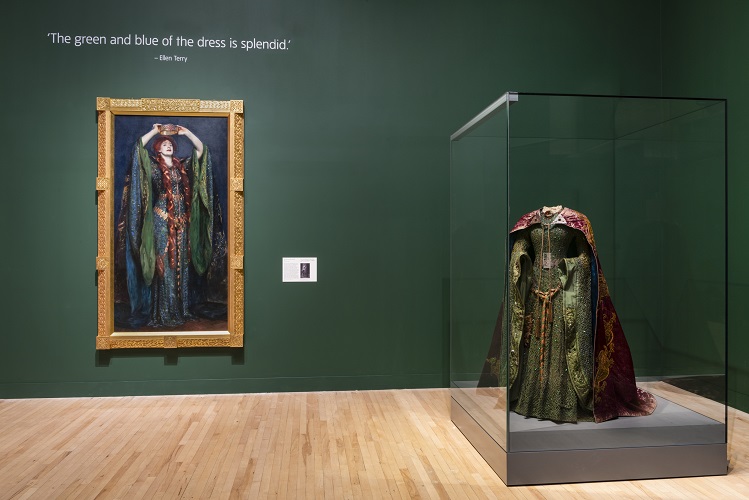 Opening this week at Tate Britain is a major exhibition dedicated to the great portrait painter John Singer Sargent (1856-1925). Sargent and Fashion brings together 60 of the artist’s portraits with period dresses and accessories – many of them worn by his sitters and reunited for the first time with the portraits of their wearers – to show how Sargent used dress and fashion as a powerful tool.
Opening this week at Tate Britain is a major exhibition dedicated to the great portrait painter John Singer Sargent (1856-1925). Sargent and Fashion brings together 60 of the artist’s portraits with period dresses and accessories – many of them worn by his sitters and reunited for the first time with the portraits of their wearers – to show how Sargent used dress and fashion as a powerful tool.
The exhibition reveals how, through his sartorial choices, Sargent helped to establish the individuality of his sitters and developed his own aesthetic agenda.
John Singer Sargent was renowned for the ability to bring his subjects to life. He worked collaboratively with his sitters but, rather than being driven purely by the sensibilities of his wealthy clientele, he also took creative liberties, changing and omitting details as he saw fit. He regularly chose their outfits or manipulated their clothing, as in Lady Sassoon 1907, which is displayed at the start of the exhibition alongside the original black taffeta opera cloak worn in the image, revealing how he pulled, wrapped, and pinned the fabric to add drama to his portrait. In this respect, Sargent was working in a similar way to how an art director at a fashion shoot would today.
The exhibition sheds light on the artist’s key patrons, including nobility and influential members of the community. Highlights include Lady Helen Vincent, Viscountess d’ Abernon 1904 and Mrs. Charles E. Inches (Louise Pomeroy) 1887, which is juxtaposed with the red velvet evening dress illustrated. The regalia worn by Charles Stewart, sixth Marquess of Londonderry at the Coronation of Edward VII 1904 is reunited with the painting to show how the artist conveyed both rank and personality through clothing.
Sargent was able to take even more creative freedoms with non-commissioned portraits, such as his iconic painting of socialite Virginie Amélie Gautreau, Madame X 1883-4, which caused a stir at the Salon by salaciously showing Mme Gautreau with one diamond strap falling from her shoulder.
Sargent’s artistic process and relationships are further explored using photographs, drawings, garments and accounts written by his sitters. Key works such as Mrs Montgomery Sears 1899 are shown alongside Mrs Sears’ own dresses and her photographs of Sargent at work, while Mrs Fiske Warren and her Daughter Rachel 1903 is displayed with photographs documenting the portrait sittings in process.
Sargent and Fashion also explores the artist’s subversion of social codes and conventions through portraiture. His clothing choices suggest the blurring of characteristics that once defined masculine and feminine appearance, reflecting the shifting ground of traditional gender roles at the end of the 19th century. Sargent’s portrait Vernon Lee 1881 exemplifies this approach. Lee was the pseudonym of the British writer Violet Paget, who used the name professionally and personally. Her preference for severe, almost masculine clothing, shows a refusal to conform to conventional notions of femininity. The exhibition also features one of Sargent’s most dramatic and unconventional male portraits, Dr Pozzi at Home 1881, depicting the aesthete surgeon Samuel-Jean Pozzi in a flamboyant red dressing gown and Turkish slippers.
In addition to his patrons, Sargent chose to portray professional performers, including dancers, actors, and singers, which allowed him to indulge his taste for visual spectacle. His dramatic image of Ellen Terry as Lady Macbeth 1889 is exhibited alongside Terry’s dress and cloak, as well as La Carmencita 1890, depicting 21-year-old Spanish dancer Carmen Dauset Moreno, who performed in music halls across the United States, Europe, and South America. For the first time, visitors have the chance to view this stunning portrait next to the dancer’s sparkling yellow satin costume.
Organised in collaboration with the Museum of Fine Arts Boston, Sargent and Fashion offers a new generation and those already familiar with the artist’s work the chance to discover and reconsider Sargent and his enduring influence.
For further information: tate.org.uk
Smith Greenfield is an independent insurance broker specialising in insurance for exclusive lifestyles and collectors of valuable objects including: art insurance, antiques insurance, jewellery insurance, watch insurance, vintage car insurance, fine wine insurance and more. To discuss specialist insurance for your lifestyle, please contact our Premier Client Adviser, Imran Moideen: imran.moideen@smithgreenfield.co.uk
Image: Sargent and Fashion installation view with Ellen Terry as Lady Macbeth and Beetle-Wing Dress at Tate Britain 2024 Photo © Tate (Jai Monaghan)

